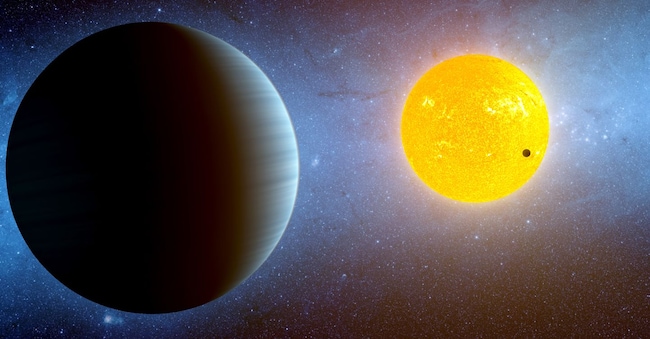Kepler-10c, the mystery of the completely frozen exoplanet


Kepler-10c is an exoplanet, orbiting a star other than our Sun, and has been known for more than a decade. Today, thanks to an international research led by Italy, we know it is a completely frozen world.
Using observations made with the TNG, Telescopio Nazionale Galileo located in the Canary Islands and specialized in the search for planets orbiting other stars, the enigma that has fascinated scientists since the discovery of Kepler 10c in 2011 has been solved: why is it so massive and yet so relatively small.
It is about 560 light-years from Earth, very close in astronomical terms, out of reach for us today, and was initially classified as a “mega-Earth”.
It has a mass of 17 times that of Earth but a radius only 2.35 times larger, so it is much denser than us. Why this high density, scientists have wondered for years, and now the recent work of the international group of astrophysicists, led by Aldo Bonomo of the INAF, National Institute for Astrophysics, published in an important professional journal in the field, can help us understand why: the planet could be entirely frozen.

Until now it was thought that the high density of Kepler-10c was due to the fact that it was a rocky planet, like our Earth, but the Italian-led study has led to a reconsideration of the question: it is possible that Kepler-10c is a world composed mainly of a large core of water, solidified in an extreme form, enclosed by a shell of rocky and metallic materials.
With this discovery, however, new problems arise, as always in scientific research: the planet must have remained in an icy state since its formation, and the age of the planetary system of the star Kepler-10 is estimated at about 10 billion years, more than double ours and certainly older than Earth, which we estimate to be 4 billion years old.
Keeping an entire planet frozen for such a long period requires particular and extreme conditions, such as the existence of a primitive atmosphere and the lack of any geothermal activity: in practice a bit of atmosphere that freezes due to the extreme temperatures of the universe and no volcanoes, geysers or similar that heats the planet itself. It would therefore be a water world, a world in which the water component is predominant.
“The existence of 'water worlds' has been predicted theoretically, but we still don't have a certain confirmation,” said Aldo Bonomo of INAF in Turin, who led the researchers from INAF and the universities of Padua, Turin and Milan. “The proof of the existence of these planets should come from the study of their atmospheres with the James Webb space telescope because we expect them to have atmospheres particularly rich in water vapor.”
James Webb, the most powerful space telescope in existence, by NASA, Europe and Canada is actually racking up one discovery after another, given its exceptional performance, impossible for a ground-based telescope.
To date, we know of over 5,000 confirmed exoplanets, with many more awaiting verification. These planets, which orbit stars other than our Sun, offer an extraordinary variety of characteristics: rocky worlds like Kepler-452b, gas giants like HD 209458b, and planets with extreme atmospheres like WASP-121b.
Kepler-10c is an example of how every discovery leads us to further questions, such as whether it is really completely frozen, how it formed and how it remained stable.
In the search for new planets, with the secret hope of finding a new Earth, each new step forward brings us closer to the answer to the question that humans have always asked themselves: are we alone in the universe ?
News and insights on political, economic and financial events.
Sign upilsole24ore





